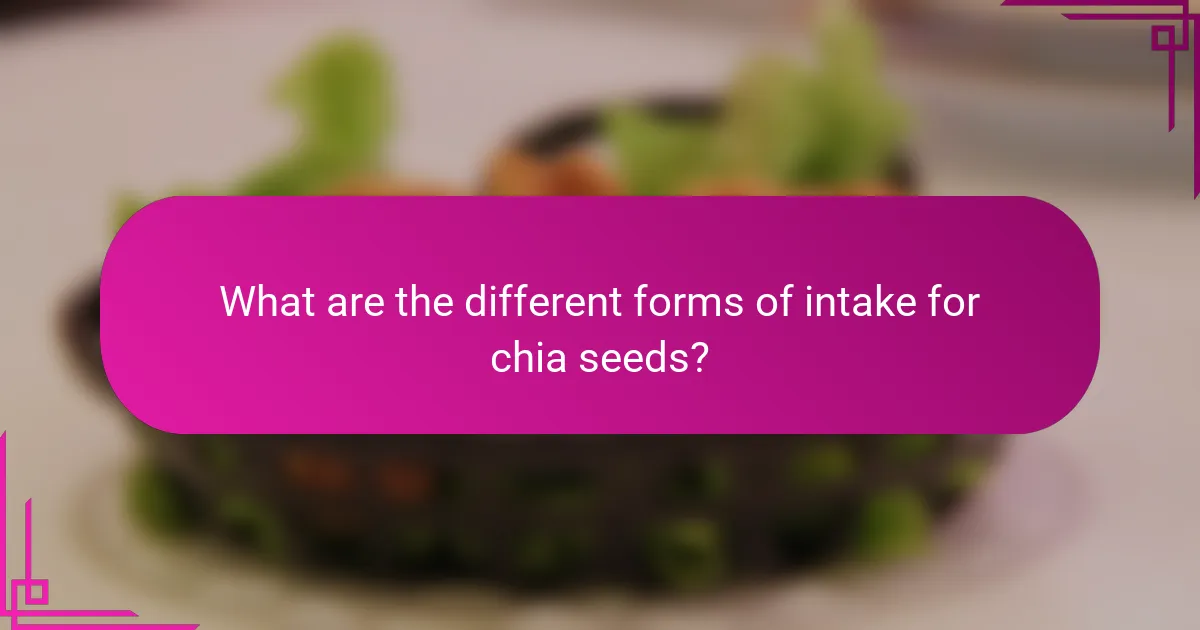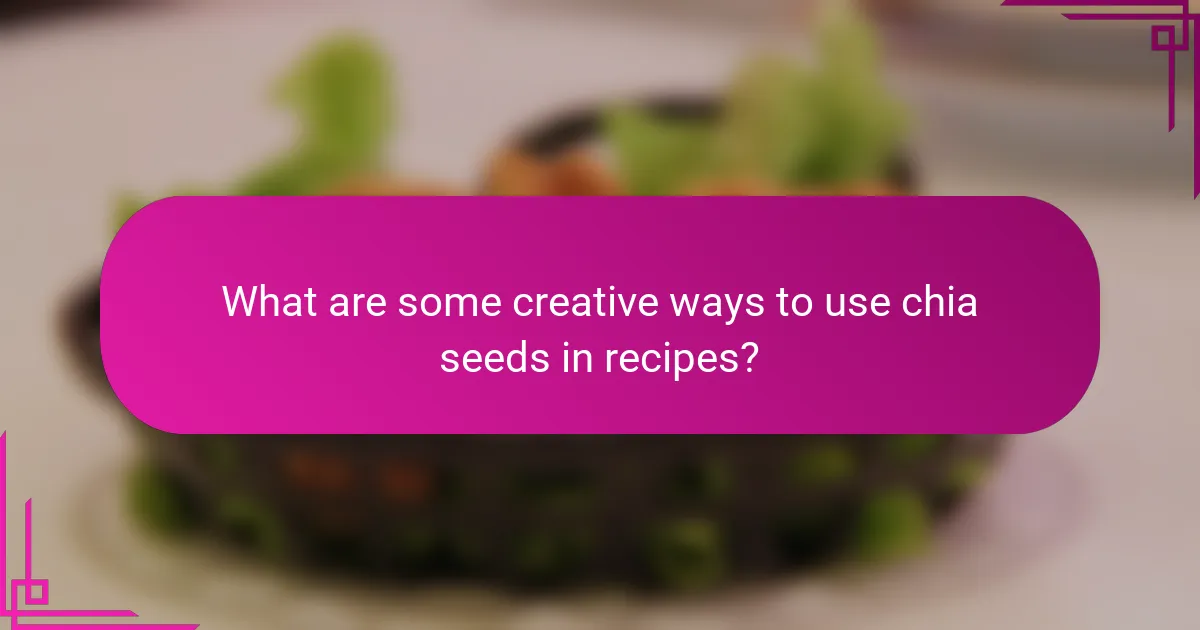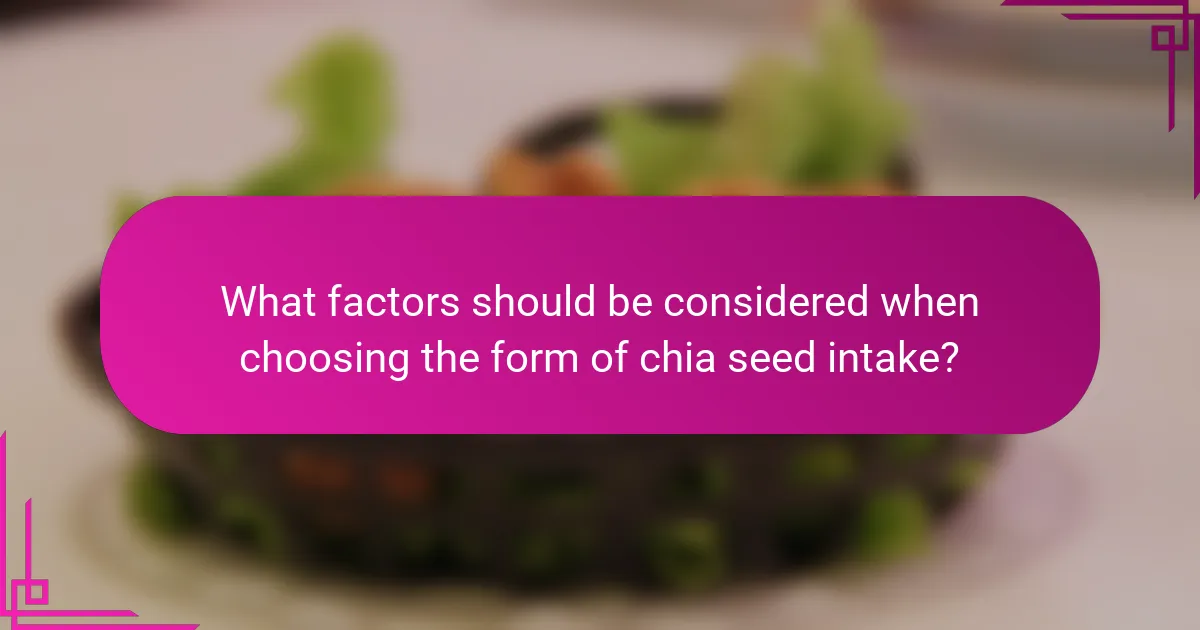Chia seeds are a versatile superfood that can be consumed in various forms, including whole, ground, soaked, and as oil. Each form offers unique textures and culinary applications, such as adding crunch to salads, enhancing smoothies, or creating gel-like puddings. The digestibility and nutritional absorption of chia seeds can vary based on their form, with ground seeds often being easier to digest. Personal preference and intended use also influence the choice of intake method, making chia seeds a flexible addition to a balanced diet. This article explores the different ways to incorporate chia seeds into meals while highlighting their health benefits.

What are the different forms of intake for chia seeds?
Chia seeds can be consumed in various forms. They can be eaten whole, providing a crunchy texture. Ground chia seeds can be used in smoothies or baking. Soaked chia seeds form a gel-like consistency, ideal for puddings. Chia seed oil is another option, often used in salad dressings. Chia seeds can also be added to yogurt or oatmeal for extra nutrition. Each form retains the nutritional benefits, such as omega-3 fatty acids and fiber.
How can chia seeds be consumed in their whole form?
Chia seeds can be consumed in their whole form by adding them directly to various foods and beverages. They can be sprinkled on salads for added crunch and nutrition. Whole chia seeds can also be mixed into smoothies for a nutrient boost. Additionally, they can be added to yogurt or oatmeal for texture and health benefits. When consumed whole, chia seeds provide fiber, protein, and omega-3 fatty acids. The seeds can absorb liquid, expanding and creating a gel-like consistency, enhancing the overall dish.
What are the benefits of eating whole chia seeds?
Eating whole chia seeds offers numerous health benefits. They are rich in omega-3 fatty acids, which support heart health. Whole chia seeds provide dietary fiber, aiding in digestion and promoting satiety. They contain antioxidants that help combat oxidative stress in the body. Whole chia seeds are a good source of protein, contributing to muscle repair and growth. They also supply essential minerals like calcium, magnesium, and phosphorus, which are vital for bone health. Research indicates that incorporating chia seeds into the diet can improve metabolic health and reduce inflammation.
How do whole chia seeds affect digestion?
Whole chia seeds positively affect digestion. They are high in dietary fiber, which promotes regular bowel movements. The soluble fiber in chia seeds absorbs water and forms a gel-like substance in the digestive tract. This gel slows digestion and helps maintain a feeling of fullness. Studies show that a high-fiber diet can reduce constipation and improve gut health. Additionally, chia seeds contain prebiotics that support beneficial gut bacteria. This can enhance overall digestive health.
What are the advantages of ground chia seeds?
Ground chia seeds offer several advantages. They are easier to digest compared to whole seeds. This is due to the breakdown of the seed’s outer shell. Ground chia seeds provide better nutrient absorption. They are rich in omega-3 fatty acids, fiber, and protein. One ounce contains about 5 grams of protein and 11 grams of fiber. This aids in promoting satiety and digestive health. Additionally, ground chia seeds can be easily incorporated into various recipes. They can be added to smoothies, baked goods, and oatmeal. This versatility enhances their use in a balanced diet.
How does grinding chia seeds impact nutrient absorption?
Grinding chia seeds enhances nutrient absorption. Whole chia seeds have a hard outer shell that can limit nutrient bioavailability. Grinding breaks down this shell, making nutrients more accessible. Studies show that ground chia seeds increase the absorption of omega-3 fatty acids. This is due to the release of alpha-linolenic acid when the seeds are ground. Additionally, nutrients like fiber and protein become easier to digest. Research indicates that ground chia seeds can lead to higher levels of antioxidants in the body. Overall, grinding chia seeds significantly improves nutrient uptake compared to consuming them whole.
What are the best practices for grinding chia seeds?
To grind chia seeds effectively, use a high-quality grinder. A coffee grinder or a spice grinder works best for this purpose. Ensure the seeds are dry before grinding to achieve a fine consistency. Grind in small batches to prevent overheating and maintain nutrient integrity. Aim for a duration of 10 to 15 seconds for optimal results. Store the ground chia seeds in an airtight container to preserve freshness. Ground chia seeds can be used in smoothies, baking, or as a thickening agent. This method enhances nutrient absorption and provides a smoother texture in recipes.
How can chia seeds be incorporated into beverages?
Chia seeds can be incorporated into beverages by adding them directly to drinks. They can be mixed into smoothies for added texture and nutrition. Chia seeds absorb liquid and create a gel-like consistency, enhancing the drink’s thickness. They can also be added to water, juices, or teas for hydration and health benefits. For optimal incorporation, allow chia seeds to soak in the liquid for about 10-15 minutes. This soaking time helps them expand and blend better into the beverage. Nutritionally, chia seeds are rich in omega-3 fatty acids, fiber, and protein, making them a healthy addition to various drinks.
What types of drinks can include chia seeds?
Chia seeds can be included in a variety of drinks. Common types are smoothies, juices, and flavored waters. Chia seed lemonade is popular for its refreshing taste. Some people add chia seeds to herbal teas for added nutrition. Coconut water with chia seeds is also a favored combination. Protein shakes often incorporate chia seeds for extra protein. Additionally, chia seed drinks can be found in pre-packaged beverages. These drinks benefit from the nutritional properties of chia seeds, including omega-3 fatty acids and fiber.
How do chia seeds alter the texture of beverages?
Chia seeds alter the texture of beverages by creating a gel-like consistency. When soaked in liquid, chia seeds absorb water and expand. This process results in a thicker, more viscous texture. The gel formation occurs due to soluble fiber in the seeds. Studies show that chia seeds can absorb up to 12 times their weight in water. This unique property enhances the mouthfeel of drinks. Additionally, the texture can make beverages more filling. The altered texture can also enhance the visual appeal of drinks.

What are some creative ways to use chia seeds in recipes?
Chia seeds can be creatively used in various recipes. They can be added to smoothies for a nutritional boost. Chia seeds create a gel-like consistency when soaked in liquid. This property makes them ideal for puddings. Combine chia seeds with almond milk and sweetener for a simple pudding. They can also be used as an egg substitute in baking. Mix one tablespoon of chia seeds with three tablespoons of water for each egg. Chia seeds enhance the texture of baked goods like muffins and bread. They can be sprinkled on salads for added crunch. Incorporating chia seeds into yogurt or oatmeal increases fiber content. These methods highlight the versatility of chia seeds in different culinary applications.
How can chia seeds be added to smoothies?
Chia seeds can be added to smoothies by blending them directly with other ingredients. Start by measuring one to two tablespoons of chia seeds. Add them to your blender along with fruits, vegetables, and liquids like water or milk. Blend the mixture until smooth. Chia seeds can also be soaked in water for 15 minutes before adding to smoothies. This allows them to expand and create a gel-like texture. The seeds provide a nutritional boost, offering omega-3 fatty acids, fiber, and protein.
What are some popular smoothie recipes featuring chia seeds?
Some popular smoothie recipes featuring chia seeds include the Berry Chia Smoothie, Mango Chia Smoothie, and Green Chia Smoothie. The Berry Chia Smoothie combines mixed berries, yogurt, and chia seeds. This smoothie is rich in antioxidants and fiber. The Mango Chia Smoothie features ripe mango, coconut milk, and chia seeds. It provides a tropical flavor with healthy fats. The Green Chia Smoothie includes spinach, banana, and chia seeds. This recipe is nutrient-dense and energizing. Each of these smoothies utilizes chia seeds for added health benefits, such as omega-3 fatty acids and protein.
How do chia seeds enhance the nutritional profile of smoothies?
Chia seeds enhance the nutritional profile of smoothies by providing essential nutrients and beneficial compounds. They are rich in omega-3 fatty acids, which support heart health. Chia seeds also contain high levels of fiber, aiding digestion and promoting satiety. Additionally, they are a good source of protein, contributing to muscle repair and growth.
These seeds are packed with antioxidants, which help combat oxidative stress in the body. Chia seeds also provide minerals such as calcium, magnesium, and phosphorus, supporting bone health. When mixed with liquids, they absorb water and expand, creating a gel-like texture that can improve the smoothie’s consistency.
Research shows that adding chia seeds can increase the overall nutrient density of a smoothie, making it a more balanced meal option.
What are the best ways to use chia seeds in baking?
Chia seeds can be used in baking as an egg substitute, thickener, or nutritional booster. To use chia seeds as an egg substitute, mix one tablespoon of chia seeds with three tablespoons of water. Let the mixture sit for about 15 minutes until it forms a gel-like consistency. This chia gel can replace one egg in recipes for muffins, pancakes, or cookies.
Chia seeds can also be added directly to baked goods for added texture and nutrition. Incorporating two tablespoons of chia seeds into bread or granola recipes enhances fiber and omega-3 fatty acids. Additionally, chia seeds can be soaked in liquid before adding them to batters, which helps to improve moisture retention in baked items.
Using chia seeds in baking not only enhances the nutritional profile but also contributes to the overall texture and flavor of the final product.
How can chia seeds replace eggs in recipes?
Chia seeds can replace eggs in recipes by creating a chia egg mixture. To make a chia egg, combine one tablespoon of chia seeds with three tablespoons of water. Let the mixture sit for about 10 to 15 minutes until it becomes gel-like. This gel acts as a binding agent similar to eggs in baking. Chia seeds contain soluble fiber, which helps with moisture retention and binding. Research indicates that chia seeds can effectively replace eggs in vegan baking, providing similar texture and moisture.
What are some baked goods that benefit from chia seeds?
Baked goods that benefit from chia seeds include bread, muffins, pancakes, and cookies. Chia seeds enhance the nutritional profile of these items. They provide fiber, omega-3 fatty acids, and protein. Additionally, chia seeds can improve the texture and moisture of baked goods. For example, adding chia seeds to bread can create a denser loaf. Muffins with chia seeds often have a more satisfying texture. Pancakes made with chia seeds can be fluffier and more filling. Cookies benefit from chia seeds by adding a nutritional boost without altering flavor significantly.

What factors should be considered when choosing the form of chia seed intake?
The factors to consider when choosing the form of chia seed intake include digestibility, nutritional absorption, and personal preference. Digestibility varies based on whether chia seeds are consumed whole, ground, or soaked. Ground chia seeds may be easier to digest and absorb nutrients effectively. Nutritional absorption can also be influenced by the form; soaked seeds may enhance nutrient availability. Personal preference plays a critical role in the choice of intake form, as some individuals may prefer the texture of whole seeds, while others may favor smoothies or baked goods. Additionally, the intended use, such as for hydration or as a thickening agent, can dictate the best form for consumption.
Why is it important to consider personal dietary needs?
Considering personal dietary needs is crucial for optimal health and well-being. Individual dietary requirements vary based on age, health status, and lifestyle. For instance, people with allergies must avoid certain foods to prevent severe reactions. Nutritional needs also differ; athletes may require more protein and carbohydrates. Additionally, specific medical conditions, like diabetes, necessitate careful carbohydrate management. A tailored diet can enhance nutrient absorption and overall energy levels. Research shows that personalized nutrition can lead to better health outcomes and improved quality of life. Understanding these needs helps individuals make informed food choices that support their unique health goals.
How do allergies or intolerances affect chia seed consumption?
Allergies or intolerances can significantly limit chia seed consumption. Individuals with a known allergy to chia seeds may experience symptoms such as hives, swelling, or anaphylaxis. This can lead to avoidance of chia seeds in their diet. Additionally, those with intolerances might face digestive issues like bloating or gas when consuming chia seeds. Research indicates that chia seeds belong to the Salvia genus, which can trigger reactions in sensitive individuals. Therefore, it is crucial for affected individuals to consult healthcare professionals before including chia seeds in their diet.
What role do health goals play in choosing chia seed forms?
Health goals significantly influence the choice of chia seed forms. Different forms of chia seeds, such as whole seeds, ground seeds, or chia flour, offer varying nutritional benefits. For instance, whole seeds provide high fiber content, aiding digestion, which may align with weight management goals. Ground seeds increase nutrient absorption, making them suitable for individuals seeking enhanced omega-3 fatty acid intake. Chia flour can be beneficial for those aiming for gluten-free alternatives in baking. Thus, the selection of chia seed forms is tailored to specific health objectives, ensuring optimal benefits for individual dietary needs.
How can portion sizes impact the benefits of chia seeds?
Portion sizes significantly impact the benefits of chia seeds. Consuming an appropriate portion can maximize their nutritional value. Typically, a serving size of one to two tablespoons provides a rich source of omega-3 fatty acids, fiber, and protein. Larger portions may lead to excessive fiber intake, causing digestive discomfort. Research indicates that a daily intake of 15 grams of chia seeds can enhance satiety and promote weight management. This aligns with studies showing that moderation is key for optimal health benefits. Therefore, mindful portion control ensures that individuals can experience the beneficial effects without adverse reactions.
What is the recommended daily intake of chia seeds?
The recommended daily intake of chia seeds is about 1 to 2 tablespoons. This amount provides a balance of nutrients without excessive calorie intake. One tablespoon of chia seeds contains approximately 58 calories, 5 grams of fiber, and 2 grams of protein. Consuming this amount can contribute to a healthy diet. Additionally, studies suggest that this intake supports digestive health and provides essential omega-3 fatty acids. Therefore, sticking to 1 to 2 tablespoons daily is advisable for most individuals.
How can too much chia seed intake affect health?
Excessive chia seed intake can lead to digestive issues. High fiber content in chia seeds may cause bloating, gas, or constipation when consumed in large amounts. The recommended daily intake is about 1.5 to 2 tablespoons. Consuming more than this can overwhelm the digestive system. Additionally, chia seeds can absorb significant amounts of water, potentially leading to dehydration if not accompanied by adequate fluid intake. Studies indicate that large servings may interfere with nutrient absorption. Therefore, moderation is crucial for health benefits without adverse effects.
What tips can enhance the experience of consuming chia seeds?
Soaking chia seeds before consumption enhances their texture and digestibility. This process allows the seeds to absorb water and expand, creating a gel-like consistency. The gel can improve the mouthfeel when added to smoothies or yogurt. Adding chia seeds to recipes like puddings or baked goods can also enhance their nutritional profile. Mixing chia seeds with various liquids, such as almond milk or fruit juice, can add flavor and nutrients. Incorporating them into salads or oatmeal provides a crunchy texture and boosts fiber intake. Consuming chia seeds regularly can support hydration due to their high water absorption capacity.
Chia seeds are a versatile superfood that can be consumed in various forms, including whole, ground, soaked, or as oil. Each form retains essential nutritional benefits such as omega-3 fatty acids, fiber, and protein, making them suitable for a range of dietary preferences and culinary applications. The article explores the different forms of chia seed intake, their health benefits, and practical ways to incorporate them into meals and beverages. It also addresses factors influencing the choice of intake form, including digestibility, nutrient absorption, and individual dietary needs.
